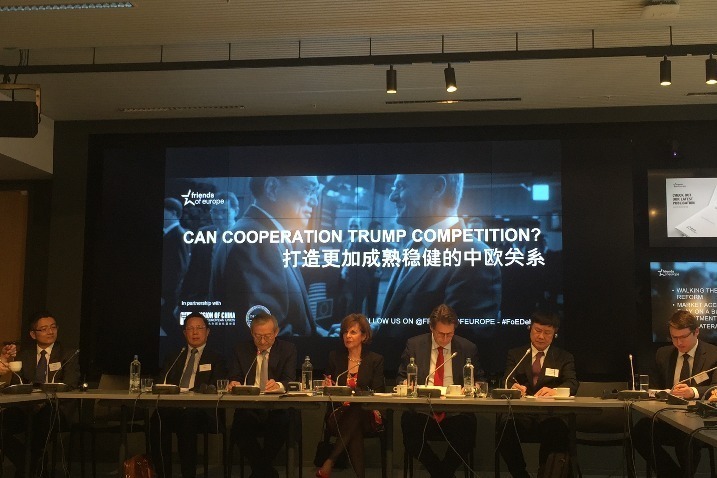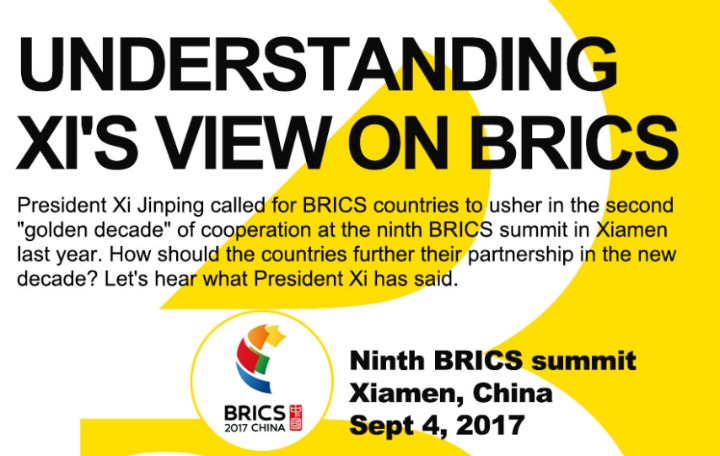Smart investment top priority
By Jia Kang |
chinawatch.cn |
Updated: 2019-10-31 15:46
The current macroeconomic situation faces significant downward pressure. Add to that internal contradictions and the worsening of the Sino-US trade frictions and the result is significant uncertainty and less-than-positive market expectations.
The need during such difficult times is to deepen reform, meaning to expand reform in all areas and expand domestic demand by taking advantage of the enormous opportunities presented by the upgrading of China's industrialization and urbanization processes.
Experts keep talking about expanding consumption, but given the gravity of the trade war, it is not possible to raise consumption without expanding investment. Consumption is the starting point and purpose of investment, and yet, consumption becomes untenable without the support of effective financing and investment.
Expanding effective financing and investment is crucial. "Smart investment" refers to selective investment that increases effective supply through structural optimization. Investment must go hand in hand with financing to ensure that the expansion of domestic consumption is sustainable.
Total investment in fixed assets in China only grew at 5.4 percent annually in 2018. The growth rate was only slightly higher, at 5.8 percent, during the first half of this year, a level hugely inconsistent with the enormous room for effective investment that currently exists in China and the urgent need for expanding domestic demand. This is a wake-up call that merits full attention.
The Central Committee of the Communist Party of China has already changed the narrative of "deleveraging" to "stabilizing leverage", with a clear call for a monetary policy that "maintains reasonable and sufficient liquidity" paired with more proactive fiscal policies. From an economics perspective, this policy combination can serve to support a moderate expansion.
Within this macro-control policy framework, more attention needs to be paid to take forceful measures to focus on smart investments through innovative mechanisms, structural optimization and expanding effective supply, so that we can enhance financing and investment mechanisms and galvanize our economy.
There are a plenty of effective investment and financing projects aimed at structural optimization, high-quality development and upgrading, that can increase the potential for socioeconomic development. Examples include urban agglomeration, as well as the upgrading or transforming of infrastructure that enables the optimization of the functions of these agglomerations, as called for by the Political Bureau of the CPC Central Committee; the supporting hardware needed for developing next-generation information technologies, which is considered a strategic emerging industry; building the cold chain for the food industry to promote integrated development of urban and rural areas and increasing the quality and sophistication of household consumption; renovation of old and rundown neighborhoods in hundreds of city districts; and the construction of parking lots and spots.
It is necessary to speed up construction of the public transportation system in Beijing, so that it reaches a level of density and connectivity close to that of New York and Tokyo. With high enough density and convenient stops, public transportation will become the top choice for urban mobility for the largest number of residents. Even though Beijing closely rivals Manhattan in the number of skyscrapers, the former still suffers from underinvestment in public transport. In parking alone, China is around 50 million places short of ensuring the quality of life its people deserve.
The so-called sponge cities are high on the agenda for many stakeholders, and planning and guidance are needed to build these cities across China as fast as possible. During flood season, cities - large, medium-sized and small - are usually ill equipped to deal with heavy rains and floods, exposing their residents' lives and properties to risks. This is an untenable situation, which calls for commitment to put in place "sponge cities" wherever needed.
River management and numerous public works in the framework of rural development should be paired with investment and financing arrangements that help expand domestic consumption, once safety and high standards are ensured. Such investments are essential for sustainable socioeconomic development, higher quality of life, lasting peace and national security, and several quality-focused modernization processes that aim at strengthening various sectors.
It will take more than a few decades to complete these processes, and therefore it is important to seize opportunities for expanding domestic demand in times of economic downturn to step up investment and financing.
While striving to make more effective investment and financing, we must make sure they are channeled into actual projects with the institutional guarantees provided by reform and innovation. In this way, a "modern market" and a "law-based business environment with high standards "can be achieved.
In order to mobilize social capital and to improve the decision-making process, policy finance is a good option. Public-private partnership projects are the most typical example; fiscal capital can leverage tools such as viability gap funding to mobilize social capital. For example, with parking lots and spots in place, companies nearby can generate cash flow once they start operating, facilitating build-operate-transfer projects.
Private companies can participate in infrastructure projects to provide public services.
But playing by the rule book is important in PPP projects. Parties should avoid unplanned and disorganized actions and keep risks at bay. More documents or rules do not always mean better management; rather, we need law-based, transparent and professional management to simplify the rules. From a macro perspective, guidance tends to work better than prohibition, and objective rules of market operation must be followed.
The relevant policy toolbox and regulatory framework should be perfected. Under the principle of law-based governance, the key to sustainable and robust policy finance is risk sharing among diverse stakeholders and transparent, professional collective decision-making mechanisms.
In conclusion, fiscal and monetary policy tools and commercial/policy finance markets should be coordinated and complementary to each other, and the top priority should be to make sure that all of these can provide support to effective investment and financing projects aimed at structural optimization and expanding domestic demand.
These measures should serve the short-and medium-term objectives of macro control, and are also key to achieving synergy between short-, medium-and long-term strategic goals of modernization.
The author is head of the China Academy of New Supply-side Economics.
The author contributed this article to China Watch exclusively. The views expressed do not necessarily reflect those of China Watch.
All rights reserved. Copying or sharing of any content for other than personal use is prohibited without prior written permission.
The current macroeconomic situation faces significant downward pressure. Add to that internal contradictions and the worsening of the Sino-US trade frictions and the result is significant uncertainty and less-than-positive market expectations.
The need during such difficult times is to deepen reform, meaning to expand reform in all areas and expand domestic demand by taking advantage of the enormous opportunities presented by the upgrading of China's industrialization and urbanization processes.
Experts keep talking about expanding consumption, but given the gravity of the trade war, it is not possible to raise consumption without expanding investment. Consumption is the starting point and purpose of investment, and yet, consumption becomes untenable without the support of effective financing and investment.
Expanding effective financing and investment is crucial. "Smart investment" refers to selective investment that increases effective supply through structural optimization. Investment must go hand in hand with financing to ensure that the expansion of domestic consumption is sustainable.
Total investment in fixed assets in China only grew at 5.4 percent annually in 2018. The growth rate was only slightly higher, at 5.8 percent, during the first half of this year, a level hugely inconsistent with the enormous room for effective investment that currently exists in China and the urgent need for expanding domestic demand. This is a wake-up call that merits full attention.
The Central Committee of the Communist Party of China has already changed the narrative of "deleveraging" to "stabilizing leverage", with a clear call for a monetary policy that "maintains reasonable and sufficient liquidity" paired with more proactive fiscal policies. From an economics perspective, this policy combination can serve to support a moderate expansion.
Within this macro-control policy framework, more attention needs to be paid to take forceful measures to focus on smart investments through innovative mechanisms, structural optimization and expanding effective supply, so that we can enhance financing and investment mechanisms and galvanize our economy.
There are a plenty of effective investment and financing projects aimed at structural optimization, high-quality development and upgrading, that can increase the potential for socioeconomic development. Examples include urban agglomeration, as well as the upgrading or transforming of infrastructure that enables the optimization of the functions of these agglomerations, as called for by the Political Bureau of the CPC Central Committee; the supporting hardware needed for developing next-generation information technologies, which is considered a strategic emerging industry; building the cold chain for the food industry to promote integrated development of urban and rural areas and increasing the quality and sophistication of household consumption; renovation of old and rundown neighborhoods in hundreds of city districts; and the construction of parking lots and spots.
It is necessary to speed up construction of the public transportation system in Beijing, so that it reaches a level of density and connectivity close to that of New York and Tokyo. With high enough density and convenient stops, public transportation will become the top choice for urban mobility for the largest number of residents. Even though Beijing closely rivals Manhattan in the number of skyscrapers, the former still suffers from underinvestment in public transport. In parking alone, China is around 50 million places short of ensuring the quality of life its people deserve.
The so-called sponge cities are high on the agenda for many stakeholders, and planning and guidance are needed to build these cities across China as fast as possible. During flood season, cities - large, medium-sized and small - are usually ill equipped to deal with heavy rains and floods, exposing their residents' lives and properties to risks. This is an untenable situation, which calls for commitment to put in place "sponge cities" wherever needed.
River management and numerous public works in the framework of rural development should be paired with investment and financing arrangements that help expand domestic consumption, once safety and high standards are ensured. Such investments are essential for sustainable socioeconomic development, higher quality of life, lasting peace and national security, and several quality-focused modernization processes that aim at strengthening various sectors.
It will take more than a few decades to complete these processes, and therefore it is important to seize opportunities for expanding domestic demand in times of economic downturn to step up investment and financing.
While striving to make more effective investment and financing, we must make sure they are channeled into actual projects with the institutional guarantees provided by reform and innovation. In this way, a "modern market" and a "law-based business environment with high standards "can be achieved.
In order to mobilize social capital and to improve the decision-making process, policy finance is a good option. Public-private partnership projects are the most typical example; fiscal capital can leverage tools such as viability gap funding to mobilize social capital. For example, with parking lots and spots in place, companies nearby can generate cash flow once they start operating, facilitating build-operate-transfer projects.
Private companies can participate in infrastructure projects to provide public services.
But playing by the rule book is important in PPP projects. Parties should avoid unplanned and disorganized actions and keep risks at bay. More documents or rules do not always mean better management; rather, we need law-based, transparent and professional management to simplify the rules. From a macro perspective, guidance tends to work better than prohibition, and objective rules of market operation must be followed.
The relevant policy toolbox and regulatory framework should be perfected. Under the principle of law-based governance, the key to sustainable and robust policy finance is risk sharing among diverse stakeholders and transparent, professional collective decision-making mechanisms.
In conclusion, fiscal and monetary policy tools and commercial/policy finance markets should be coordinated and complementary to each other, and the top priority should be to make sure that all of these can provide support to effective investment and financing projects aimed at structural optimization and expanding domestic demand.
These measures should serve the short-and medium-term objectives of macro control, and are also key to achieving synergy between short-, medium-and long-term strategic goals of modernization.
The author is head of the China Academy of New Supply-side Economics.
The author contributed this article to China Watch exclusively. The views expressed do not necessarily reflect those of China Watch.
All rights reserved. Copying or sharing of any content for other than personal use is prohibited without prior written permission.









